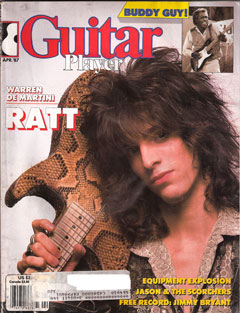Warren DeMartini’s 1987 Ratt Rig: Part 1
 I remember the Guitar Player magazine with Warren DeMartini on the cover – because it never arrived. I remember looking forward to it, I remember seeing it in guitar stores, but it never arrived at my house even though I was a subscriber. That’s how guitar-crazy the ’80s were: someone at the post office stole my magazine!
I remember the Guitar Player magazine with Warren DeMartini on the cover – because it never arrived. I remember looking forward to it, I remember seeing it in guitar stores, but it never arrived at my house even though I was a subscriber. That’s how guitar-crazy the ’80s were: someone at the post office stole my magazine!
I’ve always been curious about that particular issue, so as a fan of Warren’s playing, I picked up a copy of that issue (April 1987) on eBay. The interview is…eh…but has some decent info. Following are the tone parts. (It looks like Warren and Robbin Crosby were first interviewed by Guitar Player for the August 1984 issue, after Out of the Cellar but before Invasion of Your Privacy, which of course had “Lay it Down.”)
While reading, bear in mind that Warren was a big fan of George Lynch. And if you listen to Warren’s Ratt solos with that in mind, you can hear some George licks – and even some George tone.
All quotes below are Warren’s. Some info is also taken from the web, notably warrendemartini.net.
Amps
“…the best and only way for me is to just plug the guitar straight into the amp. I try to get as few things as possible hanging me up between the guitar and amplifier, instead of having a lot of effects going while I’m recording.
“I do work with the sound a lot, mainly with the EQ settings on the Marshall amps – the presence, bass, mid and treble. I bought quite a few Marshalls a couple of years ago, and of those I found three or four real nice ones that always worked pretty well in the studio.”
“Aside from the bass, I like to set everything anywhere from 10 o’clock to 2 o’clock. The bass is off, and presence is always pretty hot because that’s the least active EQ on a Marshall. The treble is anywhere from 0 to 10. I always keep the volume and master volume as loud as they will go without making it muddy.”
Talking about the Dancing Undercover album, the most recent Ratt release at the time of the GP interview: “I had been playing most of the tracks with two Marshall heads together. One was a newer 100-watt that has the larger letters, plastic switches and a master volume. I hooked this up with an older ’60s head that doesn’t have the same cosmetic look that most of them do. On the plate where the knobs [are], it’s got a plastic, plexiglass feel instead of a brushed-metal feel.
“It’s not very loud; it’s a 100-watt, but volume-wise it sounds more like a 50…. But it’s got a lot of warmth to it. So one of [the amps] was really loud, and the other was a little tonier.
“But then something happened to where this setup wasn’t working. I didn’t want to take a break and lose the moment I was in, so I just took everything apart, plugged straight into one head and one or two cabinets, and just finished everything out that way.”
Guitars
His guitars are alder-bodied with a maple neck and fingerboard, Floyd Rose trem and a Seymour Duncan JB pickup (a higher-output pickup originally made for Jeff Beck). The alder through the Marshall gives his sound that characteristic upper-mid honkiness.
The Charvel DeMartini signature guitars that came out recently have the same woods (the fingerboard is a 12-16″ compound radius with jumbo frets) with a custom Duncan pickup. Presumably that pickup is the Duncan Custom Shop DeMartini pickup, which is a lot like the JB, and is even more like George Lynch’s Super V pickup (more on all that in this prior post).
> You can also get high-quality (and super high-dollar) Warren replica guitars from Performance Guitars, the folks who built several of Warren’s guitars.
Favorite Setup
“Just the guitar with a clear, kind of high output active [the JB is not active like an EMG] pickup that has a lot of harmonics in it. That, a cord, about 20 feet, and a Marshall amp and one or two cabinets. My favorite speakers are 25-watt Celestions, the ones they haven’t made for a long time. My all-time favorite pickup is Seymour Duncan’s Jeff Beck model.”
Stage Rig
“My new Sony wireless…goes into the receiver, and that goes to a Marshall 100-watt amplifier. The output of that amp’s preamp section goes into a control board for the effects I’m using, which are a Lexicon PCM-41 delay, a PCM-42 delay, and the Yamaha SPX90 [multi-effects unit].
“From there it goes out to two Mesa/Boogie power amps and then two 30-watt Celestion cabinets. The volume is controlled at the Mesa.”
_____
Round and Round, 1984!
Category: Celestion speakers, Charvel, Lexicon, Marshall, Seymour Duncan, Warren DeMartini, Yamaha













